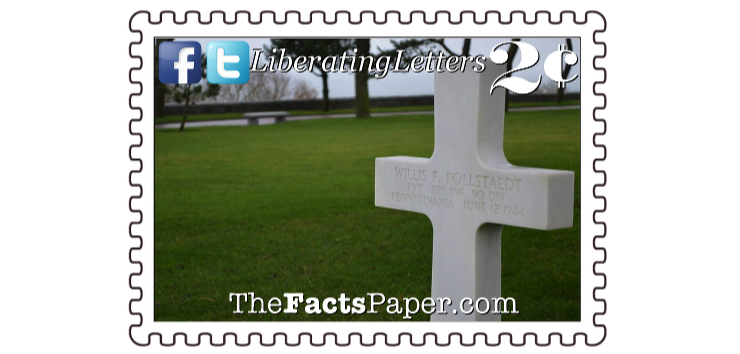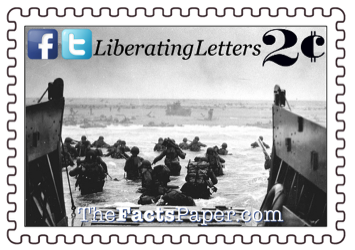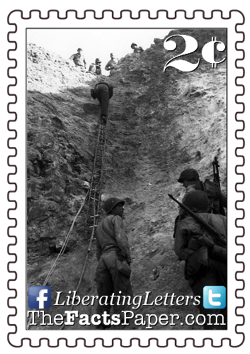
Another grave at the cemetery holds someone much dearer to our family, Liberty. Your great-grandfather’s 19-year-old cousin, Willis Frederick Follstaedt, was part of the wave that stormed Utah Beach on June 7-8, 1944. Part of the 358th Infantry Regiment, 90th Infantry Division, nicknamed the “Tough Ombres,” it is unknown exactly when Willis was wounded, but he died on June 12, and was laid to rest at Normandy American Cemetery in France. He, like so many others, gave his life for a cause bigger than himself.
Beginning in World War I, military leaders designated operation launch dates as D-Day. This was a placeholder until an actual date was chosen, and also to keep that date from being discovered by the enemy. Because of its massive importance, June 6, 1944, has become known and is memorialized as “D-Day,” with the events of Omaha Beach gathering the most attention.
Following the end for the war in the European Theater, Allied forces turned their attention to Japan. By this time, FDR had died and Harry S. Truman was now President. He and his military advisors were developing another “D-Day” sized invasion on Japan. Estimates of casualties and fatalities exceeded those of Normandy. Confronted by the significant loss of life and knowing the Japanese were determined to fight until the last man fell, Truman made the extremely tough decision to use the power of the Atomic Bomb at Hiroshima and Nagasaki, not to take lives, but to save lives. This equally tough decision swiftly ended World War II. (See Notice To The Japanese People)
Liberty, with the help of the passage of time and a want to vilify the actions of past generations, we as a county have been traveling down a road that has forgotten the sacrifices of the brave men and women that fought and died for our country. When you forget that sacrifice, the gift of freedom becomes much less important and we lose our passion to preserve it. Today 19 year-olds are seeking safe spaces on college campuses. (see Walking To Freedom) That safe space already exists. It’s called the United States of America. It was made safe due to the sacrifice of 19 year-old Rangers, Raiders, frogmen, and Marines. There is no safe space on a beach with jagged cliffs and mortar rounds. They confronted those dangers as a sacrifice to us. Never forget that. Doing so makes you grateful, not self-righteous. And it makes you determined to make something of your life to honor their legacy.
It is said: “Remember only two defining forces have ever offered to die for you. Jesus Christ and the American Soldier. One died for your soul, the other for your freedom.” (see Memorial Day: Honoring The Highest Sacrifice)
Liberty, NEVER forget the sacrifice of Christ or the soldier as both liberated you. Only in remembrance and honor will you desire to fight to keep it.
That’s my 2 cents.
Love,
Mom
As Russia battled Germany on an Eastern Front, Britain and France engaged them on the Western Front. Following the Allies evacuation of France at Dunkirk in 1940, Russia repeatedly petitioned the Allies to reengage Germany on the European mainland, especially after America entered the conflict. The goal was to divide Germany’s forces and attention. Such actions were postponed by President Franklin D. Roosevelt (FDR) and Prime Minister Winston Churchill while America built up her forces and engaged in other easier conflicts in North Africa and Italy. (see The British Bulldog)
Supreme Allied Commander, General Dwight D. Eisenhower, and British General Bernard Montgomery devised plans for ‘Operation Overlord,’ a water invasion from Britain across the English Channel. Germany’s General Erwin Rommel anticipated such an attack, building up a 2,400-mile defense consisting of bunkers, concrete gun emplacements, landmines, metal tripods and other anti-tank obstacles, known as the “Atlantic Wall.” Some estimates determine the Nazis planted roughly 4 million landmines within Normandy’s beaches. Despite the significant defenses, some sections of the wall were never completed.
Beginning April 1, 1944, 11,000 British and American aircraft flew 200,000 missions dropping nearly 200,000 tons of bombs. They targeted rail centers and roads in France to hinder additional German troops from reinforcing those in Normandy. Other sorties bombarded German military facilities such as airfields, radar installations, transportation links, coastal artillery batteries, and bases. Paratroopers cut railroad lines, destroyed bridges, and captured landing fields. The successful impairment of all bridges spanning the Seine and Loire Rivers, effectively isolated Normandy from the rest of France, cutting off reinforcements and supplies. In addition, gliders delivered troops, artillery, and small vehicles within the coastal area. The mission was a success at the cost of 2,000 Allied aircraft.
While the onslaught of air raids continued, a dress rehearsal dubbed ‘Exercise Tiger’ was conducted on April 27 to drill infantry on invading a beach and moving equipment. Miscommunication of landing time resulted in an unknown number of deaths from “friendly fire” meant to simulate a real invasion. The following day, as the exercise continued, nine German E-Boats surprised and attacked the Allied forces, killing 749 American troops and quickly escaping before the Allies were able to counterattack. More soldiers lost their lives to other miscalculations and under-training. While the mock invasion was a complete disaster, and the participants were sworn to secrecy, several corrections were made that later saved lives during the Normandy Invasion.
The plan to retake Europe from Germany consisted of several phases within “Operation Overlord.” The objective of the first phase, “Operation Neptune,” consisted of invading and overtaking Normandy, France. Bad weather delayed their operation by a day before orders came through to commence as planned on June 6, 1944. Any further delay would disrupt the carefully orchestrated invasion, which relied heavily on the moon and the tides. Ships left the coasts of Great Britain and headed towards Normandy’s five beaches: Utah, Omaha, Gold, Juno, and Sword. While 12 Allied nations participated in the operation, the United States provided the majority, followed by Britain and Canada.
Starting at midnight, bombers pounded the coast and multiple targets inland in attempts to handicap the German offensive. However, heavy cloud cover over Omaha beach led to missed targets. Shortly after, paratroopers in the 82nd (see A Reluctant Hero) and 101st Airborne jumped with several paratroops landing in flooded marshland where many drowned under the weight of their packs. Others at Sword beach were simply shot out of the sky.
American troops were sent to Utah and Omaha beaches with Britain and Canada attacking the rest. Allied troops experienced minimal opposition at four of the beaches, but Omaha proved to be a blood bath. America’s finest, the 1st Division, met their German equals at Omaha, as well as multiple other obstacles. (see Duty First)
In addition to rough waters from storms sending boats a significant distance from their landing target, cloud cover over Omaha beach obstructed pre-invasion efforts by bombers. This allowed the German defenses to remain intact on the high cliffs. Perched high on the ridge, German gunners held perfect positions allowing a sniper’s advantage over men with only grains of sand and water as cover. On Utah Beach, boats arrived a mile off course from their intended landing site. Undeterred, Brigadier General Theodore Roosevelt Jr. assessed the situation with a cane in hand and a pistol on his hip, declaring, “We’ll start the war from right here.” Quickly ordering the remaining boats to reroute their landings, he settled the 4th Infantry Division on the beach, ready to take on the Germans.
In the largest seaborne invasion in history, nearly three million infantry, naval, and air force Allied troops crossed the English Channel in Operation Neptune. Due to the tragic dress rehearsal and the weather conditions, Eisenhower briefly entertained the possibility of a failed mission. Before the operation began, he penned a letter to be distributed in such a case. In it, as all great leaders do, he took responsibility if it failed: "If any blame or fault attaches to the attempt it is mine alone." Hours after our troops began their invasion, President Roosevelt addressed the American people, offering a humble prayer for blessing, protection, and peace. (See D-Day vs. Today: How Far We've Come)
Allied forces proceeded to flood the coastline with troops and supplies as they began to overtake Normandy. Operation Neptune continued until the Allies secured Normandy on June 30. Additional phases in Operation Overlord proceeded until August 19, when Allied forces pushed the Germans back and crossed the River Seine. Nine months later, Adolf Hitler awoke from his delusional dream of world domination to discover the cold truth; The Allies were here and they had won. Taking the cowards way out, he committed suicide on April 30, 1945. Germany signed an unconditional surrender a week later on May 7. The last German troops left Normandy and the surrounding islands two days later.
The bold invasion was the turning point of the war. But it didn’t come without a significant cost. On June 6, the Allies suffered at least 10,000 casualties. There were almost 4,500 confirmed dead with Omaha Beach alone accounting for 2,000 of those. With many men proceeding to the sea, accurate fatality numbers still remain unknown. It is estimated that by the end of the operation, Allies suffered more than 209,000 casualties with thousands more missing. Hitler endured an equal 200,000 casualties with another 200,000 troops captured by Allied forces. In addition, fifteen to twenty-thousand French civilians lost their lives due to bombardments and ground battles. However, without victory in Operation Neptune and Operation Overlord, Europe may very well have remained in the hands of Germany or possibly fallen into Russian control.
Normandy provided a piece of land near Colleville-sur-Mer designated for the fallen soldiers of the Normandy Invasion. Among the 9,387 soldiers resting there is World War I veteran, Theodore Roosevelt, Jr. President Roosevelt’s son had participated in America’s first offensive victory at Cantigny in WWI and was the oldest soldier deployed on June 6th where he would lead his troops in another major victory in the Second World War (see Big Red Won) Despite suffering from partially crippling arthritis received from injuries in WWI, Roosevelt’s outstanding leadership on Utah Beach earned him a Medal of Honor. However, he died of a heart attack on July 12 before he could receive it personally. His body was later interned and buried next to his brother, Second Lieutenant Quentin Roosevelt, who was shot down in France during World War I.
June 6, 2019
Dear Liberty,
The steep cliffs of Normandy stood silent before a horizon filled with the greatest invasion force in history. From those jagged cliffs German machine gunners and artillery men waited with pounding hearts as they prepared to hold off an enemy that couldn’t be numbered. As the front doors to the invading vessels fell open, German bullets ripped through Allie soldiers, wiping out entire crews before the first man could take a step. With overwhelming firepower and extreme precision, the Germans targeted officers to eliminate those in charge and claiming their leaderless men as a follow-up prize. Off in the distance, artillery shells pounded other landing craft that never even made it to shore.
Men scrambled to enter the cover of water. Some found themselves struggling ashore in waist-high water, exposing their upper bodies, which allowed machine guns and mortar rounds to grind through them like gruesome wood chippers. Others jumped off into deeper water, disappearing below the surface, held down by the weight of their packs or succumbing to bullets that managed to find them. Survivors quickly discarding their equipment and rifle, making their way through blood red water with just their nose above the surface. The soldiers remained underwater, sometimes for hours, as they slowly headed towards shore no faster than the incoming tide would allow. Their chance at survival depended on it.
SAFE SPACES

Once on land, soldiers scrambled to find a safe space, dodging dead and wounded soldiers blanketing the beach as machine gun fire rained from above. With no place to go, these young men, often without leadership, pushed forward, making their way to the seawall and then to the foot of the bluff. Those with the strength scaled the cliffs while others found trails up the bluff. Pockets of survivors reached the top where the fight to overtake the high ground began.
America remained neutral in what became World War II, as they had in World War I, for as long as they could. (see The Day America’s Neutrality Sank) Following Japan’s attack on Pearl Harbor, America had no choice but to engage Japan. (see A Date Which Will Live In Infamy) As a result of the Tripartite Pact, Germany and Italy responded by declaring war on the United States. Less than 25 years after ‘The War To End All Wars’, the world was once again ablaze. (see Veterans’ Day)



